|
|
 |
|
Cyclopoida ( Order ) |
|
|
|
Lubbockiidae ( Family ) |
|
|
|
Lubbockia ( Genus ) |
|
|
| |
Lubbockia wilsonae Heron & Damkaer, 1969 (F,M) | |
| | | | | | | Syn.: | Lubbockia aculeata : Vervoort, 1951 (p.151); 1957 (p.148, Rem.) | | | | Ref.: | | | Heron & Damkaer, 1969 (p.9, Descr.F, figs.F); Heron & Damkaer, 1978 (p.13, figs.F,M); Gardner & Szabo, 1982 (p.128, figs.F,M); Razouls, 1994 (p.192, figs.F,M); Huys & Böttger-Schnack, 1996/97 (p.248, figs.F,M); Boxshall & Halsey, 2004 (p.577, p.576: fig.M) | 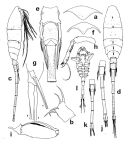 issued from : Heron G.A. & Damkaer D.M. in Smiths. Contr. Zool., 1978, 267. [Fig.9, p.14]. Female (NE Pacific): a, rostrum (ventral view); b, right Mx1. Male: c, habitus (lateral view); d, idem (dorsal view); e, first 3 urosomal segments (ventral view); f, rostrum (ventral view); g, A1 distal esthete bases x, y, and z; h, left A2; i, right Mxp. Stade V, female: j, urosome (ventral view). Stade V, male: k, urosome (ventral view). Stade III: l, habitus (ventral view, except basal segment, and swimming leg rami omitted).
|
 issued from : G.A. Heron & D.M. Damkaer in Smiths. Contr. Zool., 1978, 267. [p.2, Fig.1]. Scales used in drawing figure. Each scale = 0.1 mm.
|
 issued from : G.A. Heron & D.M. Damkaer in Smiths. Contr. Zool., 1969, 20. [p.9, Fig.11]. Female: habitus (dorsal). Scale bar: 0.100 mm. Nota : Rostral area moderately well developed. Dorsal surfaces of the prosome and urosome bear minute setules (the more conspicuous ones as indicated in figure) Urosome with small spinules in distinctive patterns on ventral posterior margin of each segment. Caudal rami about one-half the length of anal segment.
|
 issued from : G.A. Heron & D.M. Damkaer in Smiths. Contr. Zool., 1969, 20. [p.10, Fig.12]. Female: habitus (lateral). Scale bar: 0.100 mm.
|
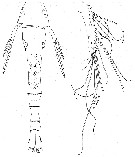 issued from : G.A. Heron & D.M. Damkaer in Smiths. Contr. Zool., 1969, 20. [p.11, Figs.13-14]. Female: Urosome (ventral; showing posterior margin of urosomal segments); A1. Scale bar: 0.100 mm. Nota : Pedigerous segment of P5 with minute spinules on dorsal and ventral surfaces. Genital apertures lateral, each encircled with ring of sclerotization from which P6 protrudes. A1 6-segmented ; less than one-half the length of cephalosome. Armature : segment I : 4 elements ; II : 6 + 1 aesthete, 1 spine ; III : 4 elements ; Iv : 3 + 1 aesthete ; V : 2 + 1 aesthete ; VI : 6 + 2 aesthetes. P5 with free segment one-fourth the length of genital segment and bearing patches of minute surface spinules. Armature consisting of 2 flanged setae, the inner nearly twice the length of the outer. Outer distal margin of segment with small process. P6 probably represented by well-developed segment protruding from genital aperture. Segment with chitinous plaque on ventral surface and 2 nude terminal setae of unequal length.
|
 issued from : G.A. Heron & D.M. Damkaer in Smiths. Contr. Zool., 1969, 20. [p.12, Fig.15]. Female: a, A2; b, labrum. Scale single bar: 0.100 mm; double bars: 0.010 mm. Nota : A2 subprehensile, 3-segmented ; 2 subapical setae, 1 nude and 1 with row of hairs on concave edge ; armed terminally with 3 claws, 1 twice the width of the other 2, and 1 seta with row of hairs. Labrum with 2 posteroventral lobes bearing marginal spinules.
|
 issued from : G.A. Heron & D.M. Damkaer in Smiths. Contr. Zool., 1969, 20. [p.13, Fig.16]. Female: a, Md; b, Mx2. Scale double bars: 0.010 mm. Nota : Md with posterior margin of base sclerotized and followed distally by slightly curved element with row of graduated hairs on outer edge . Large U-shaped central area of surface zclerotization encircles wide, flat, hirsute seta and 2 clusters of hairs, 1 long and 1 short. Second wide hirsute seta on posterior distal margin of surface sclerotization. Md terminates in long blade with row of graduated, obtuse, scalelike denticles on outer margin. Mx2 with 1st segment expanded and bearing 2 clusters of fine hairs. Second segment with small setule on outer margin and bladelike seta on posterior surface ; inner margin with plumose, lashlike seta with row of long hairs arising near the base ; distal part of segment bearing a strong nude element ; a seta, fringed with a row of spinules grading to hairs, arises near the base of this element. A thin, flat element arises at the base of the seta (one preparation suggested that additional thin, flat element are hidden by the first.
|
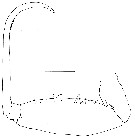 issued from : G.A. Heron & D.M. Damkaer in Smiths. Contr. Zool., 1969, 20. [p.13, Fig.17]. Female: Mxp. Scale single bar: 0.100 mm; Nota : Mxp with patch of small denticles on basal segment ; anterior margin of 2nd segment with 5 or 6 triangular spines and short and long row of small denticles. Number and pattern of spines and denticles varied between the 2 specimens, as well as between right and left appendage (1 specimen with 6 triangular spines on the left 2nd segment and 5 on right). Third segment short, unarmed ; terminal claw with 1 small proximal denticle and row of dentiform spines on concave margin (number varying between the 2 specimens).
|
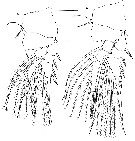 issued from : G.A. Heron & D.M. Damkaer in Smiths. Contr. Zool., 1969, 20. [p.14, Fig.18]. Female: a, P1; b, P2. Scale single bar: 0.100 mm;
|
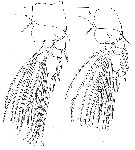 issued from : G.A. Heron & D.M. Damkaer in Smiths. Contr. Zool., 1969, 20. [p.15, Fig.19]. Female: a, P3; b, P4. Scale single bar: 0.100 mm;
|
 issued from : G.A. Heron & D.M. Damkaer in Smiths. Contr. Zool., 1969, 20. [p.12]. Female: Armature of swimming legs P1 to P4. Setae: Arabic numerals; Roman: spines; Si: inner borber of segments; Se: outer border of segments; St: terminal border of segments.
| | | | | Compl. Ref.: | | | Razouls & al., 2000 (p.343, tab. 4, Appendix); Galbraith, 2009 (pers. comm.) | | | | NZ: | 2 | | |
|
Distribution map of Lubbockia wilsonae by geographical zones
|
| | | | | |  Chart of 1996 Chart of 1996 | |
| | | | Loc: | | | Antarct. (Atlant., Indian, SW Pacif.), G. of Alaska, off British Columbia (rare) | | | | N: | 4 | | | | Lg.: | | | (25) F: 2,7-2,36; (31) F: 2,99; (674) [Pacif. NE] F: 2,98-2,64; M: 2,08-1,96 ; [Antarct.] M: 2,44-2,42 ; (676) F: 2,75-2,7; {F: 2,36-2,99; M: 1,96-2,44} | | | | Rem.: |
Sampling depth (Antarct.) : 1000-2000 m.
The highly surprising distribution of this very uncommon form was confirmed by Heron & Damkaer (1969, 1978), for the authors, Vervoort (1951, 1957) identified an Antarctic species as L. aculeata, but mentioned that the 1st segment of Mxp had, instead of 1 large spine, a cluster of small spines; after examination of the Vervoort's specimen, the form is considered as L. wilsonae, extending the distribution record from the Gulf of Alaska to the Antarctic Ocean. | | | Last update : 15/01/2015 | |
|
|
 Any use of this site for a publication will be mentioned with the following reference : Any use of this site for a publication will be mentioned with the following reference :
Razouls C., Desreumaux N., Kouwenberg J. and de Bovée F., 2005-2025. - Biodiversity of Marine Planktonic Copepods (morphology, geographical distribution and biological data). Sorbonne University, CNRS. Available at http://copepodes.obs-banyuls.fr/en [Accessed January 05, 2026] © copyright 2005-2025 Sorbonne University, CNRS
|
|
 |
 |













